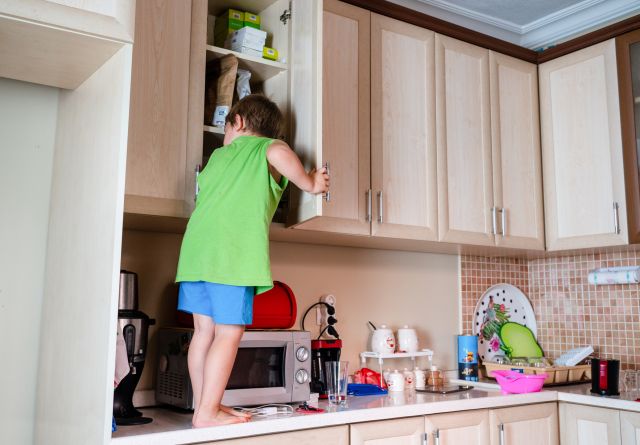Updated on January 20, 2023.
As more states move to legalize marijuana for either medical or recreational use, new research shows that an increasing number of children are being accidentally exposed to the drug. A January 2023 study published in Pediatrics suggests that more young kids are unknowingly eating edibles—foods or drinks infused with tetrahydrocannabinol (THC), which is the main psychoactive ingredient of the cannabis plant that triggers a “high.”
The study found that cannabis ingestion by children younger than 6 jumped a whopping 1375 percent between 2017 and 2021. Most of these incidents occurred at home. The researchers pointed out the number of accidental exposures that resulted in hospitalizations also surged during this time period.
“We are hoping the results of our study will raise awareness that as edible cannabis products become more common in households around the country, people recognize that they may pose a potential harm to the children in the household, and will take steps to reduce the risk of accidental ingestions,” says Marit Tweet, MD, first author of the study and an emergency medicine physician at Southern Illinois University School of Medicine in Springfield, Illinois.
What researchers found
For the study, Dr. Tweet’s team analyzed data compiled from 2017 through 2021 in the National Poison Data System, which tracks calls about potentially toxic exposures to poison control centers in 55 U.S. states and territories. The study focused on children younger than 6 because this age group is more vulnerable to accidental poisoning, accounting for almost 42 percent of human poison exposures in 2020 alone.
Their results showed 3,054 cases of edible cannabis ingestion in 2021, compared to just 207 in 2017. Almost 91 percent happened in the children’s home. Two-year old toddlers accounted for the highest percentage of cases (27.7 percent) followed by three-year olds (24.6 percent). Children in these age groups are able to open containers and climb into high spaces, but aren’t unable to understand the hazards.
While many children were treated and sent home, the researchers also found the percentage of children admitted to the hospital jumped 68 percent between 2017 and 2021. ICU admissions increased by 30 percent for pandemic years (2020-2021) compared to pre-pandemic years (2017-2019). Although the percentage of ICU admissions in 2021 was still relatively low, the study’s authors note that the severity of toxicity increased over these time periods. About 1 in 140 children had life-threatening symptoms requiring intubation and life support with a ventilator.
Why edibles are tempting kids
The rising trend isn’t new. From 2017 to 2019, U.S. Poison Control Centers reported 1,906 cases of children ages 9 or younger consuming edibles, a 2021 research brief published in Pediatrics found.
In the U.S., the use of marijuana for recreational purposes has been legalized in 21 states and the District of Columbia. Medical marijuana is also legal in 38 states and the District of Columbia. That tally may increase amid overwhelming popular support for legalization of the drug, Pew Research Center reports.
Some 56 percent of those who use marijuana legally consume edibles, making them a fast-growing segment of the cannabis market, according to researchers at NYU School of Global Public Health. Unlike medication, which is typically dispensed in child-proof containers, or alcohol that is often stored out of sight or under lock and key in homes with children, edibles often look like regular snacks and treats. Some people make them at home in their kitchen. They are also sold in the form of baked goods, candies, gummies, chocolates, and drinks.
In fact, an April 2022 study published in Drug and Alcohol Dependence suggests that some edibles look so similar to common treats that they could easily be mistaken for them. The study’s authors warn that some of these “copycat” products have THC levels that far exceed regulatory limits.
For the study, the researchers collected hundreds of edibles and analyzed their packaging. They found that 8 percent of 267 products looked just like typical snacks, including some that looked like fruit snacks, gummies, marshmallow treats, and chips. Seven of the products were branded with cartoon characters, which may seem safe or familiar and be particularly enticing to kids.
“Policies to prevent cannabis packaging from appealing to children haven’t stopped copycat products from entering the market—nor have food brands taking legal action against cannabis companies for copyright infringement,” said the study’s lead author Danielle Ompad, associate professor of epidemiology and the deputy director of the Center for Drug Use and HIV/HCV Research at NYU School of Global Public Health in an April 19, 2022 news release.
Edibles may contain sugar and salt to cover up the flavor of cannabis. And even if the packaging says that these products contain THC or CBD, many children are too young to know how to read the labels, Tweet cautions. These products are becoming more readily available, with far fewer restrictions, she adds. They’re showing up in a wide range of merchandise. Some retailers are also selling a range of CBD pet products, including oils, extracts, and treats.
Cannabis in edibles also tends to be concentrated, and one package often contains multiple servings. An adult might know to only consume a safe dose, but a small child could eat an entire package, increasing their risk for an overdose or serious complications.
What can happen to kids
Results of the 2023 study showed the most common symptom among children exposed to marijuana or edibles was central nervous system depression (experienced by 70 percent of children). Warning signs may include slurred speech, problems walking, confusion, dizziness, low blood pressure, and slowed breathing. In more severe cases, children may experience more serious effects such as seizure and coma.
“Thankfully coma and severe central nervous system effects were still relatively rare in our study,” Tweet says.
She advises parents, guardians or caregivers to watch out for common symptoms found in the study, which include:
- Unusual behavior
- Confusion or agitation
- Acting more tired than usual
- Problems walking or talking
- Vomiting
- Trouble breathing or breathing quickly
Tweet is careful to point out that the study looked only at edibles that contained THC—not CBD (cannabidiol, the main non-psychoactive component of the cannabis plant). She adds however, the risks associated with CBD products is not zero.
“It is possible to overdose on CBD if large amounts are ingested, although the toxicity is likely not as severe as with THC products,” she explains. “Signs and symptoms may still resemble those that can be seen with THC ingestion, or any other number of substances children might get into, including vomiting, not acting right, and difficulty walking.”
How to keep kids (and pets) safe
If you live in a state where marijuana use is legal and you choose to have the drug or products containing the drug in your home, it’s important to take steps to protect children and animals who live with you or may visit you.
The American College of Medical Toxicology recommends the following safety precautions:
- Do not eat or use cannabis products in front of children, who learn by watching and may think they are safe to use.
- Store cannabis products (including home-prepared ones) in child-resistant packaging and place in an out of reach, secure location like a locked container or locked cabinet.
- Clearly label products that contain cannabis.
“Store these products away from areas where other food or snack items are stored or consumed, such as the kitchen,” Tweet adds. “After use, immediately store the rest of the container. Even setting them down for a few minutes might be all a child needs to grab them.”
And think about the homes your child visits, including relatives, friends, or other caregivers. Do not be hesitant to ask if there are cannabis products in the house, and if so, how they’re stored.
If you suspect that a child has accidentally ingested marijuana or a cannabis product, call the Poison Control hotline at 1-800-222-1222. Expert help is available 24 hours a day, seven days a week.
Tweet points out however, that severe symptoms, such as losing consciousness or having trouble breathing, are a medical emergency.
“If the child is not responding or having problems breathing or other severe symptoms, call 911 or go to the emergency department,” she says.







